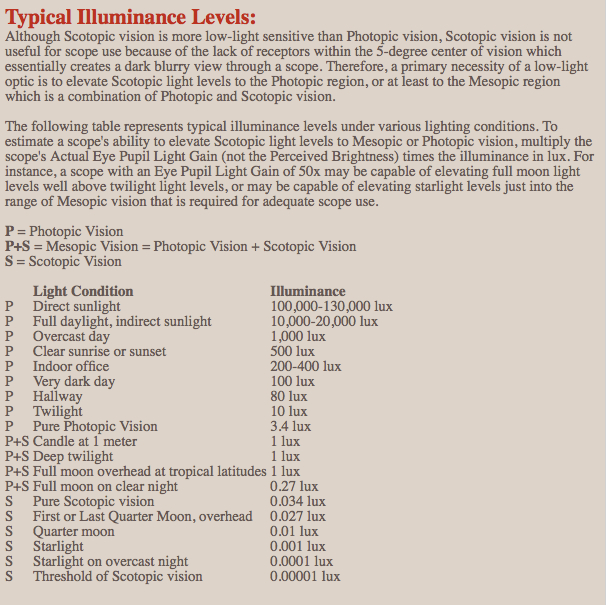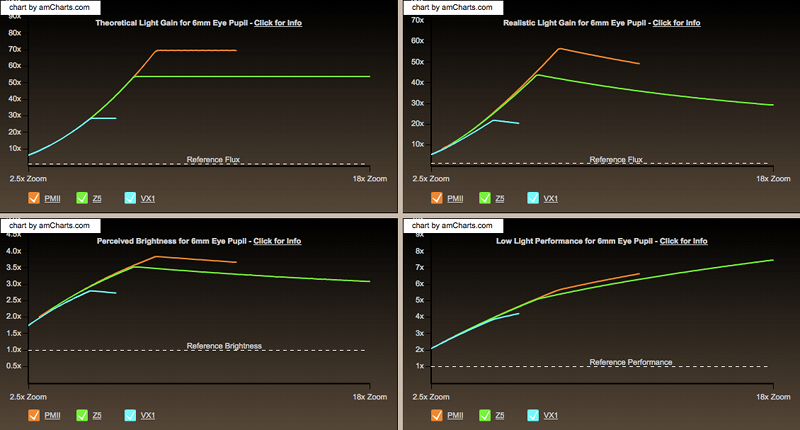In the best internet tradition of linking rather than original contribution, this site scopecalc has a good explanation of factors affecting how well a telescopic sight will perform in twilight conditions. It has an online calculator which you can put your own figures into to illustrate and compare scopes.
It explains why the capability of your own pupil to dilate can strongly affect how much benefit you'll get from a higher spec scope. Older people whose pupils can't dilate so far get less benefit from big objectives. Also why some brands like Swarovski quote smaller effective objective diameters at low power. No, its not just optical corner cutting - at powers below 5x, it really doesn't matter how big the objective is because the exit pupil is bigger than the human eye's pupil. They have a correction for "realistic light gain" which takes into account reduced resolution at higher magnification due to diffraction (bending of light around edges). I don't think "perceived brightness" is directly useful except for comfort but there is a table giving absolute illuminance values for common situations (bright sun, indoors, moonlight etc I would be interested to see what it is in NZ native bush under canopy) and relates these to the lower limit of high resolution colour vision in the human eye. Essentially, you need at least 3 - 10 lux at your pupil to see well enough to shoot. A 50mm objective can pull up full moonlight to this level at 8x but 32mm can't do it. Big objectives come into their own above 10x. Also, this shows that higher powers do give a brighter image. The idea of using low power for low light is just not right. I find I can see better in dark bush if I wind the power up and now a number says its true.
Here's a comparison of my current scope and two contenders. The site has a cursor to give you numerical values across the graphs.
Here's the brightness table.

Welcome guest, is this your first visit? Create Account now to join.
Welcome to the NZ Hunting and Shooting Forums.
Search Forums
User Tag List
+ Reply to Thread
Results 1 to 1 of 1
-
10-12-2012, 11:40 AM #1Member

- Join Date
- Mar 2012
- Location
- Waikato
- Posts
- 2,188
Scopes low light performance - link to scopecalc
-
Similar Threads
-
Creating a link..
By Pop Shot in forum Questions, Comments, Suggestions, Testing.Replies: 4Last Post: 29-11-2012, 11:29 PM -
Effect of suppressor on performance of a given load...
By .22-250 everything in forum Firearms, Optics and AccessoriesReplies: 20Last Post: 11-07-2012, 05:51 PM -
.224 75gr Hornady BTHP - terminal performance
By Beavis in forum Reloading and BallisticsReplies: 3Last Post: 28-06-2012, 08:24 PM -
7mm 180 VLD Hybrid performance on game
By leathel in forum Reloading and BallisticsReplies: 9Last Post: 22-05-2012, 07:03 PM
Tags for this Thread
Welcome to NZ Hunting and Shooting Forums! We see you're new here, or arn't logged in. Create an account, and Login for full access including our FREE BUY and SELL section Register NOW!!





 LinkBack URL
LinkBack URL About LinkBacks
About LinkBacks




 Reply With Quote
Reply With Quote


Bookmarks